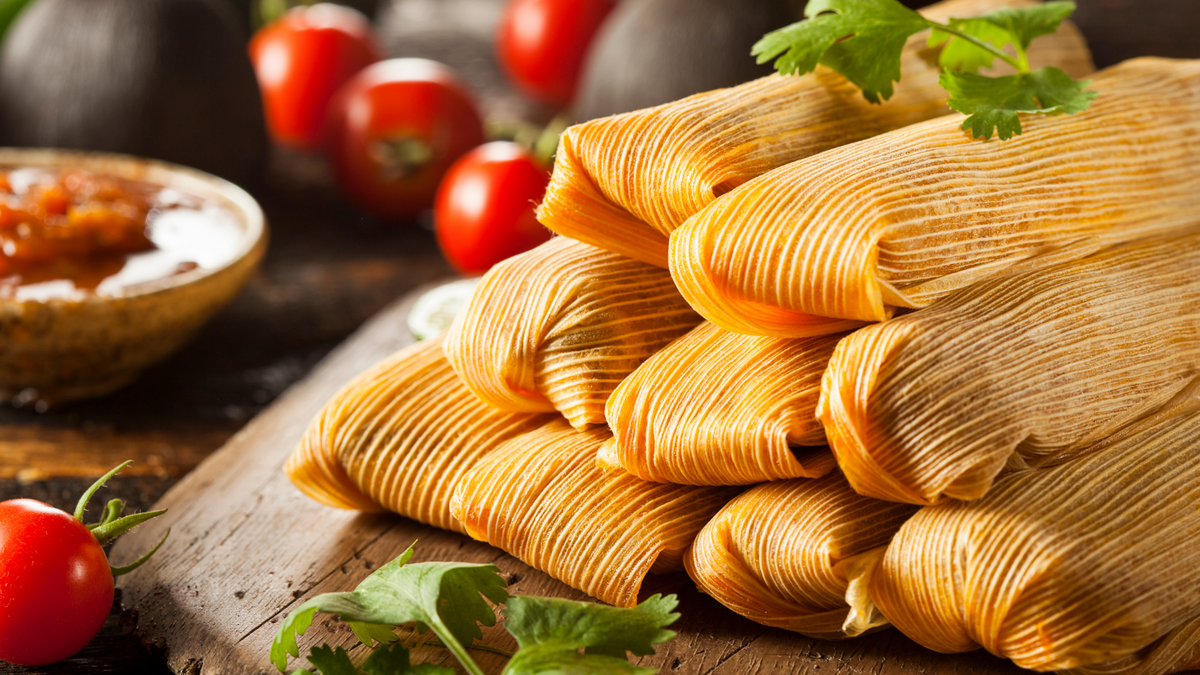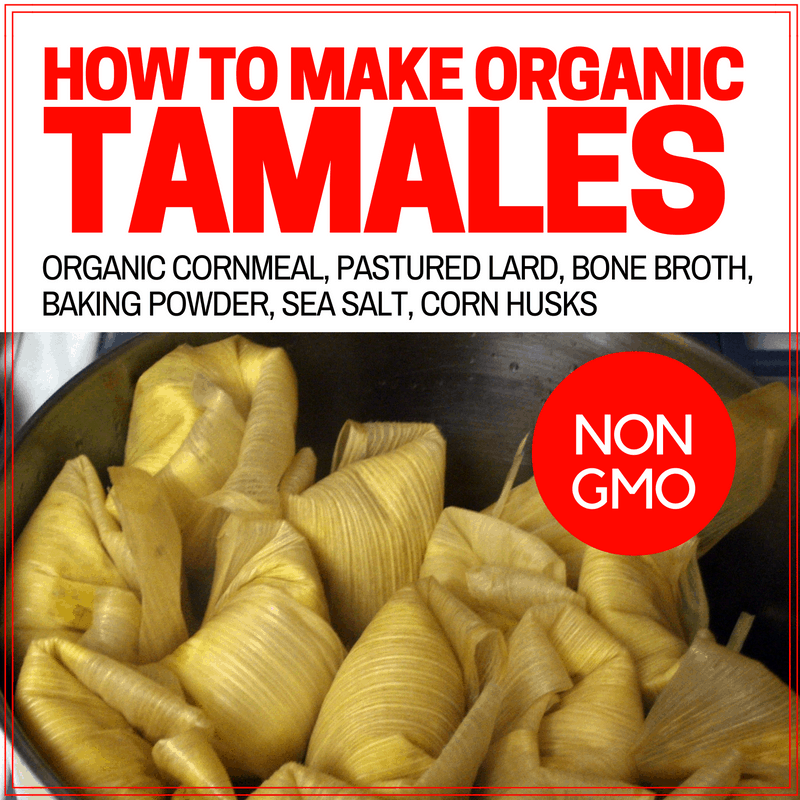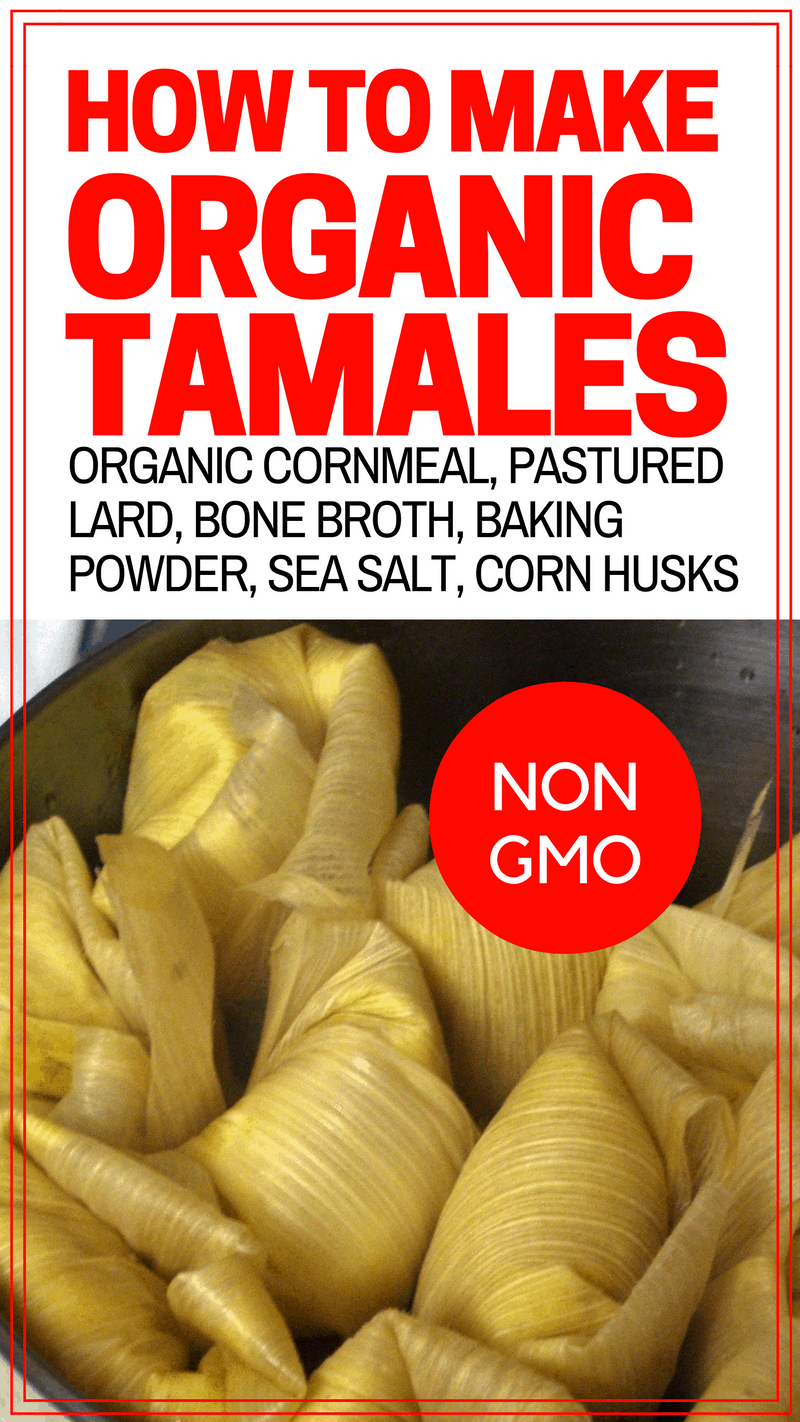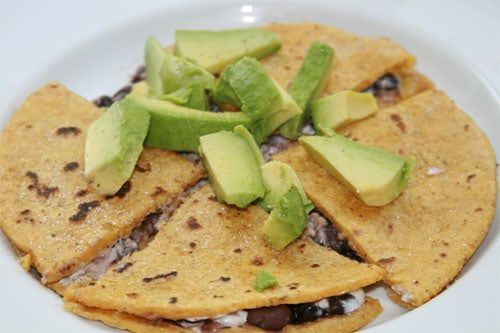How to Make Organic Tamales with Organic Cornmeal & Lard
Want to learn how to make tamales from scratch? It’s not hard. And by making your own, you can avoid the GMO cornmeal and Crisco and use use real food ingredients instead: organic cornmeal and pastured lard.

Want to learn how to make tamales from scratch? It’s not hard. And by making your own, you can avoid the GMO cornmeal and Crisco and use use real food ingredients instead: organic cornmeal and pastured lard.

It’s Christmas time, and to me that means tamales. It is traditional to eat tamales on Christmas Eve in Mexico. Tamales are also traditional in Honduras, Guatemala, Peru, and many other Latin countries.
We always go out to dinner at a restaurant on Christmas Eve, and then open our presents after dinner. I love having tamales all ready to eat on Christmas Day.
I grew up with fancy Christmas dinners with a turkey and stuffing… but with all the stress of Christmas, I love making my tamales ahead of time and freezing them, then having an easy, relaxing Christmas Day dinner of tamales served with sour cream, salsa, and fresh guacamole. My family loves Mexican food!
Why Organic Tamales with Organic Cornmeal and Lard?
Unfortunately, almost all the tamales that can be found in the United States today are made from genetically modified corn and they typically use modern industrial oils — either Crisco, soybean oil or margarine. These vegetable oils are not traditional and are very bad for you.
In this recipe, we are using lard instead of soybean oil or Crisco. Lard, or pig fat, is the traditional fat used for tamales. You can buy pastured lard online. Scroll down to the bottom for the recipe notes below on how to buy lard, as well as a substitute you can use for lard.
Our former housekeeper, Carla, is from Honduras. She taught me how to make tamales. In Honduras, they make a slightly larger tamale and they wrap them in plantain leaves. We’re doing the Mexican version, which uses corn husks.
We soaked the corn first and made masa, which is a cornmeal dough used for tamales and tortillas. We used organic cornmeal instead of Maseca, which is made from GMO corn.
This tamale filling is made from ground beef or you can use shredded pork. This is the classic beef or pork tamale. You can also stuff the tamales with cheese, beans, or vegetables like corn or potatoes. Dessert tamales stuffed with chocolate or fruit are also delicious. I’ll be posting more recipes soon, since this Christmas I’m making 4 kinds of tamales: ground beef; refried beans, cheese and potato; sweet corn and cheese; and chocolate tamales.
And stay tuned for an update on this recipe using the Instant Pot! You can make organic tamales using your Instant Pot in just 30-40 minutes. We are testing the recipe today. I will be posting soon!
How to Make Organic Tamales with Organic Cornmeal and Lard
How to Make Organic Tamales: Ingredients
Masa
Organic field or dent corn (1 1/2 pounds) or organic cornmeal (1 1/2 pounds)
Pickling lime — if making masa from dent corn (1 TBS)
Bone broth or organic chicken stock
Filling
Butter or lard (2 TBS) — how to render lard
Large yellow or white onion (1/2)
Ground beef, grass-fed (1 pound)
Tamales
A few packages dried corn husks (get a few packs because you will want to make this again & they don’t go bad)
Fresh masa — see below (1 1/2 pounds)
Lard, pastured and/or organic or refined expeller-pressed coconut oil (3/4 cup or 6 ounces)
Sea salt (1/2 tsp)
Baking powder (1 1/2 tsp)
Sour cream, from grass-fed cows if possible (1 container)
Salsa, organic (1 container)
Fresh guacamole (avocados, garlic, onion, lemon or lime, sea salt)
How to Make Organic Tamales: Equipment
Large glass bowl or enamelware Dutch oven (for soaking)
Food processor (or better yet, a grain grinder — one that can handle grinding corn)
Large stockpot with steamer insert
Tongs
How to Make Organic Tamales: Directions
Soaking Dent Corn (For Making Masa from Organic Dent Corn)
1. Rinse 1 1/2 pounds corn in a colander.
2. Add 2 quarts of filtered water to a stock pot or saucepan.
3. Mix in 1 tablespoon pickling lime and turn heat on high.
4. Pour the rinsed corn in. Remove any kernels that float to the surface.
5. Bring to a boil, then turn the heat down to a simmer. Let it cook for 10 minutes, then remove from heat and let cool.
6. At this point, you can transfer it to a glass mixing bowl and cover it with a dish cloth to let it soak (I used an enamelware Dutch oven with a lid). It’s best to soak in glass or enamelware — or stoneware. I don’t think it’s a good idea to ferment in stainless steel.
7. Mix well, cover, and let the corn soak for 24 hours.
Using Dent Corn to Make Masa
1. Rinse the soaked corn thoroughly in a colander.
2. Add the corn to the bowl of your food processor, 1 cup at a time.
3. Pulse a few times, then let it run.
4. Add anywhere from 1-4 tablespoons of bone broth per cup of corn. You just have to feel it out. Keep adding water 1 tablespoon at a time and blending until the dough is very soft and is no longer crumbly.
5. Keep pulsing and scraping down until the dough is done. You will know when it’s done when the dough is very smooth and it forms a ball on one side of your food processor.
6. Be very conservative about adding broth. If you add too much broth, the dough will be overly sticky. That’s OK though. Just add more corn and make it a little dryer, then mix it with the wetter one. If you need to, add a little dry cornmeal flour to get the right consistency.
7. Form the dough into a few large balls and wrap in plastic and store in the fridge until you are ready to make your tamales.
Using Organic Cornmeal to Make Masa
1. In a food processor, add anywhere from 1-4 tablespoons of bone broth per cup of cornmeal. You just have to feel it out. Keep adding water 1 tablespoon at a time and blending until the dough is very soft and is no longer crumbly.
2. Keep pulsing and scraping down until the dough is done. You will know when it’s done when the dough is very smooth and it forms a ball on one side of your food processor.
3. Be very conservative about adding broth. If you add too much broth, the dough will be overly sticky. That’s OK though. Just add more corn and make it a little dryer, then mix it with the wetter one. If you need to, add a little dry cornmeal flour to get the right consistency.
4. Form the dough into a few large balls and wrap in plastic and store in the fridge until you are ready to make your tamales.
Make the Tamale Filling
1. Chop the onion.
2. Add the butter or lard to a skillet and turn the heat on medium.
3. Add the onions and cook until soft.
4. Add the ground meat and cook until done.
5. Add sea salt to taste.
6. Set aside until ready to fill tamales.
Make the Tamales
1. Soften (not melt) the lard or coconut oil. A good way to do this is to put it in the dehydrator on very low heat.
2. In a food processor or by hand with a wooden spoon, mix together the masa dough, lard or coconut oil, sea salt and baking powder.
3. Tear one dried corn husk of into small strips to use as ties for the tamales. Set aside.
4. With the tapering end of the husk facing you, place a scant one-eighth cup of dough onto the husk, leaving at least a one and one- half-inch border of husk at the tapered end.
5. Make a divet with your fingers and add a small scoop of the meat filling.
6. Press the masa around the meat to cover it.
7. Fold the two long sides of the corn husk in over the corn mixture.
8. Fold the tapered end up, leaving the top open.
9. Secure the tamale by tying with a strip of the husk.
10. Do all the tamales in this manner and set aside. It’s good to have a friend or family member helping.
11. Measure 1-2 inches of filtered water in a large stockpot. Set steamer insert into pot. Set on low to medium heat.
12. Stand tamales upright in prepared steamer. Cover and steam for 1-2 hours, checking water level occasionally and replenishing with boiling water as needed. Tamales are done when they pull away from the husk easily.
13. Serve with sour cream and/or salsa (ideally lacto-fermented salsa).
How to Make Organic Tamales: Recipe Notes
This recipe for tamales comes from Chef Rick Bayless. I revised it to use fresh organic corn or cornmeal instead of the GMO masa harina that you buy at the store.
You can either soak dent corn to make masa or you can use organic cornmeal (instructions for both methods are included above). The advantages of soaking your own corn instead of using cornmeal are: (1) it’s cheaper and (2) it’s much fresher, which means it tastes better and it’s much more nutritious. But not everyone will have the time or inclination to find and soak field corn. If you do buy cornmeal instead of making masa from scratch, make sure it’s organic.
This recipe produces about a pound and a half of fresh masa. It will be enough to make a lot of tamales (you need one pound), plus a little extra. You can use the extra masa dough to make more tamales (such as a dessert tamale or a vegetable). If you don’t use it all, I recommend freezing the extra masa dough. You can use for tortillas (click here for my corn tortillas recipe). Or you can make extra tamales and freeze them. They make a delicious, easy-to-prepare dinner any night of the week. Just pop them in the oven or toaster oven!
You do need to find corn husks which can be purchased at most grocery stores or you can buy on Amazon.
It’s cheaper to buy pig fat directly from a farmer (look for pig fat from pigs raised on pasture), and rendering it yourself). You can also use refined expeller pressed coconut oil. Expeller-pressed or refined coconut oil is very healthy and it works great in tamales (I don’t recommend unrefined coconut oil, however — the coconut flavor is too strong).
Click the links below to read my recipes for making masa from scratch:
Part One: How to Soak Corn for Masa
Part Two: How to Make Masa
And here’s my recipe for rendering lard:
How to Render Lard
Pin This Post: How to Make Organic Tamales with Organic Cornmeal and Lard




Comments ()